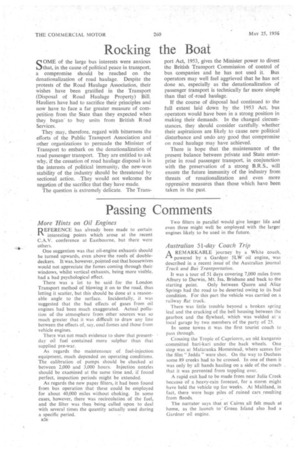Passing Comments
Page 32

Page 33

If you've noticed an error in this article please click here to report it so we can fix it.
More Hints on Oil Engines
REFERENCE has already been made to certain interesting points which arose at the recent C.A.V. conference at Eastbourne, but there were others.
One suggestion was that oil-engine exhausts should be turned upwards, even above the roofs of doubledeckers. It was, however, pointed out that housewives would not appreciate the fumes coming through their windows, whilst vertical exhausts, being more visible, had a bad psychological effect.
There was a lot to be said for the London Transport method of blowing it on to the road, thus letting it scatter, but this should be done at a reasonable angle to the surface. Incidentally, it was suggested that the bad effects of gases from oil engines had been much exaggerated. Actual pollution of the atmosphere from other sources was so much greater that it was difficult to draw any line between the effects of, say, coal fumes and those from vehicle engines.
There was not much evidence to show that presentday oil fuel contained more sulphur than that supplied pre-war.
As regards the maintenance of fuel-injection equipment, much depended on operating conditions. The calibration of pumps should be checked at between 2,000 and 3,000 hours. Injection nozzles should be examined at the same time and, if found perfect, inspection periods might be extended.
As regards the new paper filters, it had been found from bus operation that these could be employed for about 40,000 miles without choking. In some cases, however, there was recirculation of the fuel, and the filter was then being called upon to deal with several times the quantity actually used during a specific period.
n26 Two filters in parallel would give longer life and even three might well be employed with the larger engines likely to be used in the future. '
Australian 51-day Coach Trip
AREMARKABLE journey by _a White coach, powered by a Gardner 5LW oil engine, was described in a recent issue of the Australian journal Truck and Bus Transportation.
It was a tour of 51 days covering 7,000 miles from Albury to Darwin, Mt. Isa, Brisbane and back to the starting point. Only between Quorn and Alice Springs had the road to be deserted owing to its bad condition. For this part the vehicle was carried on a railway flat truck.
There was little trouble beyond a broken spring leaf and the cracking of the bell housing between the gearbox and the flywheel, which was welded at • a local garage by two members of the party of 25.
In some towns it was the first tourist coach to pass through.
Crossing the Tropic of Capricorn, an old kangaroo committed hari-kari under the back wheels. One stop was at Mataranka Homestead, where scenes for the film " Jedda " were shot. On the way to Duchess some 89 creeks had to be crossed. In one of them it was only by all hands hauling on a side of the coach that it was prevented from toppling over.
A rapid exit had to be made from near Julia Creek because of a heavy-rain forecast, for a storm might have held the vehicle up for weeks. At Maitland, in fact, there were huge piles of ruined cars .resulting from floods.
The narrator says that at Cairns all felt much at home, as the launch to GreenIsland also had a Gardner oil engine.
A MOST interesting booklet entitled "Motor 1 —1. Transport In Canada" has been published by the Goodyear Tire and Rubber Co. of Canada Ltd. As explained by the vice-president of that company, Mr. H. G. Harper, the " trucking " industry in the Dominion has been so busy doing its job that it has had no time to tell its story.
As a result the records have been incomplete and this is claimed to be the first time that anything like a history has been concentrated into one book. It is hoped that this will bring about a better understanding of the immense part road transport plays in the country's economic life.
It is pointed out that, because of its huge area and comparatively small population, no other country has been so dependent on transport for its growth and development. At first, land transport was only by stage coach and, later, railway. In 1766, there were only 170 miles of post roads, but the total increased to over 14,000 miles by 1860. Between Quebec and Montreal the coach trip was divided into 24 stages and took three days.
The first Motor goods vehicles seemed to have appeared about. 1903; in a few years they became strongly competitive with the railways, which were
also badly hit by the depression of 1929. Road. transport, being highly flexible with operators full of initiative, penetrated sections of the country ind gave services which were economically impossible by rail.
The national representative body for hauliers is • the Canadian Truck Association, founded in 1937. As examples of the strength of fleets, trucks in British Columbia numbered nearly 79,000 in 1953, in Manitoba over' 52,000 and Saskatchewan 88,000, whilst more than 14,000 communities are now wholly dependent upon road transport for the essentials of life.














































































































